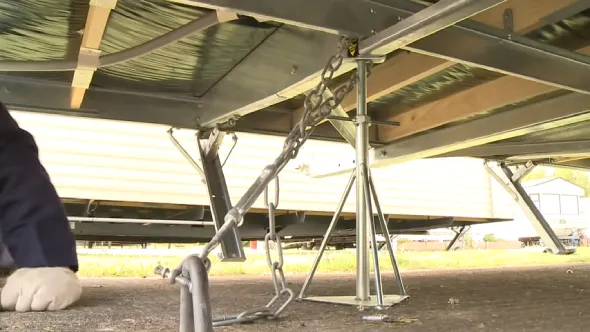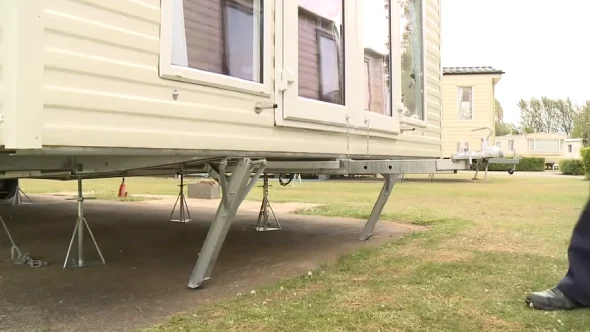Last Updated on March 21, 2023
Planning to lift your mobile home? Before you can start the job, you must know what size jack to lift the mobile home. Hydraulic jacks are the go-to tools for lifting heavy objects like mobile homes, and they come in various sizes.
When lifting a mobile home, two 10 to 30-ton hydraulic bottle jacks are typically necessary. These jacks should be placed at crossbeams, on either side of the hitch, or near each axle. You’ll also want steel jacking plates to provide stability and protection from damage during lifting.
Aside from that, it’s usually recommended to purchase a 10 or 12-ton jack for lifting a mobile home. With these sizes, you’ll be able to lift 20,000 pounds at each corner without having to pump too much.
Let’s closely inspect how these kinds of jacks lift a mobile home.
What Size Jack Would Lift 1 Pier On Mobile Home?

When lifting a mobile home, the jack size will depend on how much the pier needs to be lifted. Generally speaking, four 12-ton bottle jacks should be sufficient for lifting up most homes. This is because a typical pier can usually be lifted with about 8 tons of force.
The jacks should be placed at each end of the beam to lift the house from underneath safely. Also, heavier jacks may need to be used if more force is needed to lift the home.
Calculating how much force is necessary before attempting to lift any structure off its foundations is important. This ensures safety and prevents potential damage from overloading a jack.
How to Lift a Mobile Home with a Jack?
Leveling a mobile home with a jack is a complicated process, and it is important to do so safely and efficiently. Here are eight steps for ensuring that you lift your mobile home properly:
Step 01: Inspect the Mobile Home
Inspecting a mobile home before lifting is a critical step in the process. Start by looking for any signs of damage or weaknesses in the foundation or structure of the home. Ensure no cracks or holes in the walls, floors, or ceilings exist.
Inspect each pier and look for any signs of rot or rust. If you find any issues, they should be addressed before attempting to lift the home.
Also, check that all utility lines have been disconnected and all personal belongings have been removed from the house. This will help ensure that everything remains safe during the lifting process.
Step 02: Gather the Necessary Tools
Before beginning to lift a mobile home, gathering all the necessary tools is important. A water level and hydraulic bottle jacks (two 10 to 30-ton jacks) are essential for this task. Using steel jacking plates to distribute weight evenly and provide stability during lifting is also recommended.
You’ll also need at least one 10 or 12-ton jack, along with additional screw jacks and hydraulic jacks with a minimum capacity of 20 tons.

Step 03: Identify the Lifting Points
Once you’ve gathered all of your tools, you’ll need to identify where your jacks will be placed on the mobile home when lifting it up.
Generally speaking, most people place their jacks on crossbeams, axles, or hitches, which can typically support up to 30 tons each safely while providing enough leverage for an even lift throughout the entire structure of your mobile home.
When placing your jacks, make sure they are evenly spaced out so as not to put too much pressure on one area of your home and cause uneven lifting or buckling within certain sections during the process.
Also, use steel jacking plates between each jack and your mobile home for added stability and safety during lifting.
Step 04: Position the Hydraulic Jacks
When positioning hydraulic jacks to lift a mobile home, it is important to ensure they are placed securely and level. A professional should be consulted as to where the jacks should be placed to most safely and effectively lift the mobile home.
It is also important to consult the manufacturer’s instructions for properly positioning and using the jacks. The number of jacks needed may vary depending on the size and weight of the home, but typically four or more are used. All jacks must be placed in their designated locations before any lifting begins.
Step 5: Begin Lifting the Mobile Home
Once all of the jacks are in place, one should begin slowly pumping them to gently lift the mobile home off its foundation until it has been raised about two feet off its resting place.
Ensure that you use a water level while lifting to ensure that both sides are even. If there are any discrepancies between one side, stop pumping and adjust accordingly until it is level again.
Step 06: Adjust the Lifting Points
As you continue pumping, you may need to adjust where each jack is placed to accommodate areas such as corners or edges best. This can help ensure that your mobile home’s weight is evenly distributed throughout all of your hydraulic jacks so that nothing tips or becomes uneven during this process.
Anytime something appears off-balance, remember to stop and readjust before continuing further with lifting your mobile home.
Step 07: Secure the Mobile Home
Once the mobile home has been lifted and leveled, securing it using additional screw jacks or hydraulic jacks is important. This will ensure that the mobile home does not shift or settle after completing the lifting process.
Generally, this involves positioning a jack underneath each home corner and slowly raising it until the desired height is achieved. It is important to ensure that all four jacks are being lifted evenly, as any discrepancy could result in an uneven lift.
Once each corner has been raised, check that each pier is in a good position and put a piece of wood underneath so that they remain level.
Step 08: Lower the Hydraulic Jacks
When it comes time to lower the hydraulic jacks, it is crucial to proceed with caution. The process should begin by slowly lowering each jack at an even rate to prevent any tilting or unevenness from occurring during the descent.
It may be useful to set up two levels at opposite ends of the home while doing so, which can help maintain an even descent rate throughout. Also, measurements should be taken throughout this process to ensure that everything remains level, as any discrepancies could cause serious damage to both your home and its contents.
Once all the jacks have been fully lowered, remove them from their current positions and store them safely for future use.
Can You Level Your Mobile Home Yourself With a Jack?
Leveling a mobile home yourself with a jack is possible but should be attempted only by experienced and knowledgeable DIYers. To begin, you must gather the necessary equipment, including the appropriate jacks for the size of your mobile home, boards and blocks for support, and a level.
Once these items are gathered, set the jack on top of wooden boards or blocks in the problem area. Use caution when raising the mobile home with the jack, as too much pressure can cause damage or collapse.
As you raise the unit, have someone place the level on one of its support beams and observe how it changes until it is level. When done correctly, this may take more than one pass to level out your mobile home fully.
Remember that any minor adjustments must be made after letting your home settle for several hours once complete.
How Often Should You Have Your Mobile Home Leveled?

The answer to this question depends on several factors, such as how often you move your mobile home (if ever), weather patterns in your area, and how long ago it was initially leveled during installation.
Generally speaking, most manufacturers recommend having your mobile home releveled every 3 to 5 years or if you notice any signs of un-leveling, such as gaps between doors/windows or walls beginning to separate from each other.
Even if there isn’t an obvious issue with leveling yet, having it checked periodically can help extend its life span by ensuring that everything is structurally sound and secure over time.
If you’re unsure whether your mobile home needs leveling services, contact a qualified professional specializing in such work for an assessment and advice on what steps to take next if necessary.
Securely and Safely Lift Your Mobile Home with the Right Jack
Lifting a mobile home requires proper setup and the use of the right size jack. Whether it’s two hydraulic bottle jacks of 10 to 30 tons each or just a 10 or 12-ton jack, having the correct equipment is essential for safely lifting your mobile home.
Before beginning any project like this, it’s important to ensure that all safety protocols are followed, that your jacks are placed correctly at crossbeams, at the hitch, or at the axles, and that you have steel jacking plates nearby as well.
With these tips in mind, you should now have all the information needed to lift your mobile home safely and securely.

yes, I’m needing to lift my 24×48 double wide to restore the Cinder blocks back into place at the back door for support. should i place the 12 ton jack at the main frame or can it be placed close to where the blocks belong? thank you, robrd1961@gmail.com
Yes, you can. Just be careful that it does not get imbalanced.
what kind and how many jacks to i need for my single wide 40 ftx14 mobile home
For a single wide 40 ftx14ft motorhome, a 10-ton or 12-ton bottle jack may be suitable if you only need to raise one wheel or a small part of the RV. However, if you plan on lifting the entire weight of the motorhome, six 10-ton trailer jacks are recommended.